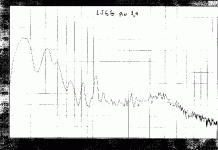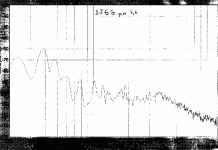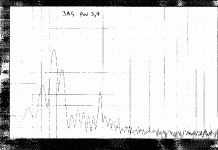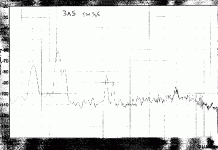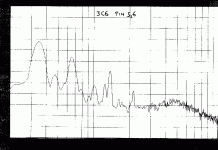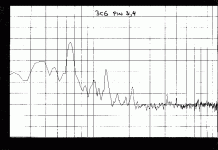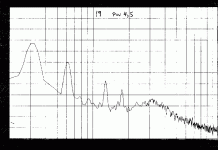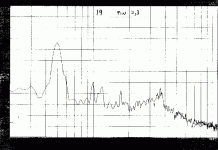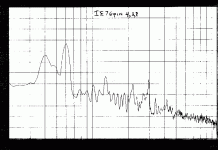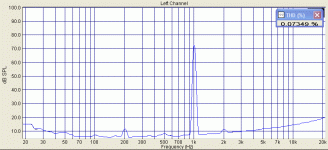DHT null?
By connecting the two halves of a double DHT triode in parallel, the effects might disappear. Assuming that a vibrating filament is the cause of the effects, I would think that vibrating toward or away from the grid would cause the largest change in Mu. If the same filament is located between the two triode halves, then motion toward one side will be motion away from the other side. So paralleling them may null out the effect. Just hypothesis at this point.
Don
By connecting the two halves of a double DHT triode in parallel, the effects might disappear. Assuming that a vibrating filament is the cause of the effects, I would think that vibrating toward or away from the grid would cause the largest change in Mu. If the same filament is located between the two triode halves, then motion toward one side will be motion away from the other side. So paralleling them may null out the effect. Just hypothesis at this point.
Don
salas said:
Thanks Lynn. Do you think that there is still potential to develop some new measurement approach that could correlate more with what audio components are actually made for? I.e. Listening. Or simply the domains you mentioned are saturated for knowledge in audio by now, and simply will never unify?
My views are probably colored by having worked for the Tektronix Spectrum Analyzer Division for 5 years. Not that they were bad spectrum analyzers; the 492 and 496 were probably the best portable swept-IF analyzers in the world at the time they were made; they were fully MIL-SPEC compliant instruments and used in military radar installations around the world.
But when you make instruments, you become intimately aware of the artifacts of measurements, and the clearly defined limits of the instruments themselves. I was the person that wrote the field calibration procedures for the 496 and the related Tracking Generator system; there's a lot of things that can subtly wrong with these things, and the most common is the failure of the operator to know what they're really looking at.
This is a metaphor, so bear with me here: I think of the audio device (tube, speaker, transformer, etc) as the 3-dimensional physical object, and the measurement as the 2-dimensional shadow cast by it. Naturally, there are several possible physical configurations that cast the same shadow, so you have to move the object around to find out what the real 3-dimension configuration is. Sometimes you have to disassemble the device to see what the internal configuration is, and even then, still move it around to find out what's inside.
This is how I see measurements. It is a shadow cast by the real thing. This shadow conveys little information by itself, and is frequently quite misleading if only a single measurement is made. The shadow - or measurement - is really a diagnostic tool, and is most usable if a number of measurements are made from different angles (different measurement domains).
The problem of the shadow/measurement is greatly compounded if you're measuring an entire component (amplifier, preamp, speaker system) instead of a single device. This geometrically increases the number of misinterpretations of the data, since there are many possible causes of what you're seeing. I call these "black-box" measurements and regard them as nearly useless - and sometimes actively misleading.
To find out what's really going inside, you have to open up the box and measure at a number of different nodes. For a speaker, this means measuring the drivers by themselves on a flat baffle, mounted on the intended baffle and/or enclosure, measuring the crossover by itself, and then measuring the whole system at different bearing angles, both extremely close-field (a few mm away from the diaphragms) and far-field (2 or more meters away at a wide range of different emission angles). Similarly, with an amplifier, the nodes inside the amplifier have to be measured, including noise and modulation effects on the power supply rails.
These "open-box" measurements are the only valid measurements as far as I'm concerned. The stuff in the magazines is only good for audio-porn, and having a good laugh at the obviously badly-designed stuff the dominates the high-end market. But the good items will tend to look all the same, and not reveal what's going on inside.
When you listen, it's a unitary gestalt experience, and what you are hearing is real-world physics, not a schemata, or an idealized representation. You are certainly not hearing the measurements, since they are reduced-dimensionality probes (or shadows) of the real thing. Of course, we don't hear everything at once, and various masking effects and human-hearing limitations apply.
On the other hand, we, unlike any computer or instrument, can anticipate what it should sound like, since we've heard an enormous catalog of music before, and have a very deep and complex set of acoustic and musical expectations to bring to the experience.
It may sound obvious, but instruments are not conscious, and have no sense of the past or future. We do, and without any conscious awareness, are continually comparing every instant to a vast array of past memories and future expectations. You aren't aware of it, but you're doing it right now as you read this posting. Much of musical enjoyment is based on subtle combinations of repetition and surprise, taking full advantage of memory and expectation. This continual dance of memory, immediate experience, and flickering sensations of expectation are what gives life its depth and meaning.
Electro-mechanical hifi systems degrade this experience. The big machine falls well short of the actual experience, in the same way that watching porn is a long way from the real thing. The interesting question is why; why does it fall short, what can we do to alleviate the disappointment, and if at all possible, deepen the mechanically induced illusion. Since the experience is a variety of hypnotic trance (a darkened room helps, since this deepens trance state), various tweaks are perfectly legitimate. The concept of accuracy is beside the point, since the real goal is an induction of a deep and convincing illusion along with the accompanying emotional and psychological states that accompany the real-world experience.
This is a higher goal than movies; the present art of theatrical exhibition wouldn't fool a child that into thinking it was the real world. But watch a movie in a high-quality 70mm wide-screen theater for a few minutes, and you get a deep hypnotic experience that blots out the real world quite successfully. An advanced high-quality music system can also induce deep hypnotic trance states; this experience, not measurements, is the real goal. The measurements are useful for research, design and diagnostic purposes, but are not the end goal. They are only a means to an end.
This hypnotic trance is the implied state of consciousness that goes along with the 5-point scale mentioned earlier. A freely expressed "What was THAT?" says something about the perceptual experience. Now, it could just be a set of consonant resonances, or a pleasing set of tonal curves and 2nd-harmonic distortion. Measurements can chase out this possibility, and should be used for that. But there are very strong perceptual experiences that don't show up in the usual measurements; this is the area for deeper exploration, and the first set of connections to explore are device geometries and operating principles.
More fun, sure. Cheapest way to improve sound.
But everyone is still sidestepping the issue of, "Can the output of the preamp be audibly distinguished from the input?" Once THAT question is answered, then if "yes," it's worth looking at the measurements and try to correlate them with sound. If it can't be, then the measurements are interesting, sure, but trying to correlate them to impressions gathered from totally uncontrolled and non-level-matched "listening sessions" is more of a social exercise than anything useful.
I don't think we have to get too mystical, verified sonic differences are easy to measure, including the effects of filament resonance. Someone with a DHT preamp who has verified in a valid listening test that the output and the input are not sonically identical could do the measurements in an hour.
But everyone is still sidestepping the issue of, "Can the output of the preamp be audibly distinguished from the input?" Once THAT question is answered, then if "yes," it's worth looking at the measurements and try to correlate them with sound. If it can't be, then the measurements are interesting, sure, but trying to correlate them to impressions gathered from totally uncontrolled and non-level-matched "listening sessions" is more of a social exercise than anything useful.
I don't think we have to get too mystical, verified sonic differences are easy to measure, including the effects of filament resonance. Someone with a DHT preamp who has verified in a valid listening test that the output and the input are not sonically identical could do the measurements in an hour.
Still agree a switch-bypass is the right way to test a two-port device that is lucky enough to have well-defined source and load impedances. If the sound is "different" but somehow "better", then we enter the sticky territory of finding out whether impedance-buffering and/or ground-loop-breaking is making the source device or power-amp happy, or if the gizmo is creating some kind of consonant coloration.
SY said:but trying to correlate them to impressions gathered from totally uncontrolled and non-level-matched "listening sessions" is more of a social exercise than anything useful.
The always laconic and sure footed SY is giving a hint here IMO. Research is one thing, and life is another thing.
The polar (bear) opposite to Lynn's circular investigations?
Not really. To me all those concepts mentioned by Lynn are thickly interwoven and readily apparent in life in general. SY is talking about checkpoints to those. One seminal question should be answered by anyone investigating such concepts right from the start, I guess. Machine or music? I prefer a mix: Musical machine with sanity check.
I acquired a few small DHT dual triodes to test: 1J6G 1J6GT 1J6GX 1G6GT 3A5 19 3C6 and 1E7 (a dual pentode). First, I had thought that maybe the same filament section was used for each triode, but that is not the case for any thus far. The triodes are separate assemblies with the filaments in series.
The 19 appears to be the same as a 1J6G but with the older 6 pin base. The 3C6 is a Loctal base.
To test these I used an IXYS CCS on the plate, set for a few mA and adjusted the grid bias for best linearity. I initially tried a Tek 7L5 spectrum analyzer, with the tracking generator output thru a SS amp to a speaker set near the tube. The input of the analyzer was the (attenuated) plate output. This gave a nice set of resonance peaks for each tube, but no easy way to get them on the computer.
So I connected the tube plate output to the computer sound card (attenuated) using a software FFT analyzer to see the spectrum. This worked similarly, but I found that if I just tapped the tube with my finger I got near the same spectrum without having to mess with the speaker. I then connected the SS amplifier input to the same (attenuated) plate signal so I could hear the signal too.
Most of the tubes sound similar to weird cow bells, and different sides of the tube are somewhat different from each other. Trying a different tube of the same type gives somewhat different results too. So, I concluded that they are not very consistant.
Some tubes however sounded like Chinese gongs, and were very interesting sounding.
One of them was amazingly good, with various ringing tones becoming prominent at different times and that weird bending sound like a musical bending sawblade in between the prominences. I'm thinking of making a doorbell with it now. But I will have to try it first in a pre-amp stage to see what it sounds like there. These gongers also tended to be more sensitive to pickup, with some even oscillating from the speaker acoustic pickup. I also checked a 6FQ7 indirect heated triode, and it was near dead silent in the same test setup. The DHTs are VERY sensitive to acoustic pickup.
So some tube spectra follow.
Don
The 19 appears to be the same as a 1J6G but with the older 6 pin base. The 3C6 is a Loctal base.
To test these I used an IXYS CCS on the plate, set for a few mA and adjusted the grid bias for best linearity. I initially tried a Tek 7L5 spectrum analyzer, with the tracking generator output thru a SS amp to a speaker set near the tube. The input of the analyzer was the (attenuated) plate output. This gave a nice set of resonance peaks for each tube, but no easy way to get them on the computer.
So I connected the tube plate output to the computer sound card (attenuated) using a software FFT analyzer to see the spectrum. This worked similarly, but I found that if I just tapped the tube with my finger I got near the same spectrum without having to mess with the speaker. I then connected the SS amplifier input to the same (attenuated) plate signal so I could hear the signal too.
Most of the tubes sound similar to weird cow bells, and different sides of the tube are somewhat different from each other. Trying a different tube of the same type gives somewhat different results too. So, I concluded that they are not very consistant.
Some tubes however sounded like Chinese gongs, and were very interesting sounding.
One of them was amazingly good, with various ringing tones becoming prominent at different times and that weird bending sound like a musical bending sawblade in between the prominences. I'm thinking of making a doorbell with it now. But I will have to try it first in a pre-amp stage to see what it sounds like there. These gongers also tended to be more sensitive to pickup, with some even oscillating from the speaker acoustic pickup. I also checked a 6FQ7 indirect heated triode, and it was near dead silent in the same test setup. The DHTs are VERY sensitive to acoustic pickup.
So some tube spectra follow.
Don
Attachments
Unfortunately, the FFT software does not seem to allow saving the spectra directly, so I have to print them, then re-scan them. The file limitations for uploading here reduce the resolution so you can't read the scales then. The bottom axis is a log freq scale from 200H to 10KHz for most of the scans. (500Hz starting on some) The vertical axis is a log (dB) scale from -140 to -20 dB.
Attachments
It's a funny thing but when I started using DHTs I was immediately struck by their microphonic nature. A few were particularly prone to ringing, like 30 and 1G4.
But the more I built the less I was troubled. What happened? I tended to use the tubes with bigger filamant currents, like 26 and 10Y. Also I built massive chassis - that was a huge step. I use 4mm alu sheets for the top plates, and bolt the chassis together tightly. I was certainly finding that more flimsy chassis would resonate, and this would transmit even into the volume control. I didn't go down the route of rubber damping and stuff, I just built massive and this seemed to do the job. All my chassis are heavy because they additionally have the filament supplies in them and those have transformers, caps and heatsinks. Weight is your friend.
I haven't revisited the more microphonic DHTs for a while - I haven't found problems with 1J6 myself, and the 3a5 wasn't too hard to control.
What sort of setup are these DHTs mounted on?
But the more I built the less I was troubled. What happened? I tended to use the tubes with bigger filamant currents, like 26 and 10Y. Also I built massive chassis - that was a huge step. I use 4mm alu sheets for the top plates, and bolt the chassis together tightly. I was certainly finding that more flimsy chassis would resonate, and this would transmit even into the volume control. I didn't go down the route of rubber damping and stuff, I just built massive and this seemed to do the job. All my chassis are heavy because they additionally have the filament supplies in them and those have transformers, caps and heatsinks. Weight is your friend.
I haven't revisited the more microphonic DHTs for a while - I haven't found problems with 1J6 myself, and the 3a5 wasn't too hard to control.
What sort of setup are these DHTs mounted on?
I would try a suspended sub chassis like in a turntable.
Smoking amp:
Use a screen capture utility instead of printing and scanning. Quick Screen Capture
Smoking amp:
Use a screen capture utility instead of printing and scanning. Quick Screen Capture
- Status
- This old topic is closed. If you want to reopen this topic, contact a moderator using the "Report Post" button.
- Home
- Amplifiers
- Tubes / Valves
- Is it worth using anything other than DHTs for preamps?
